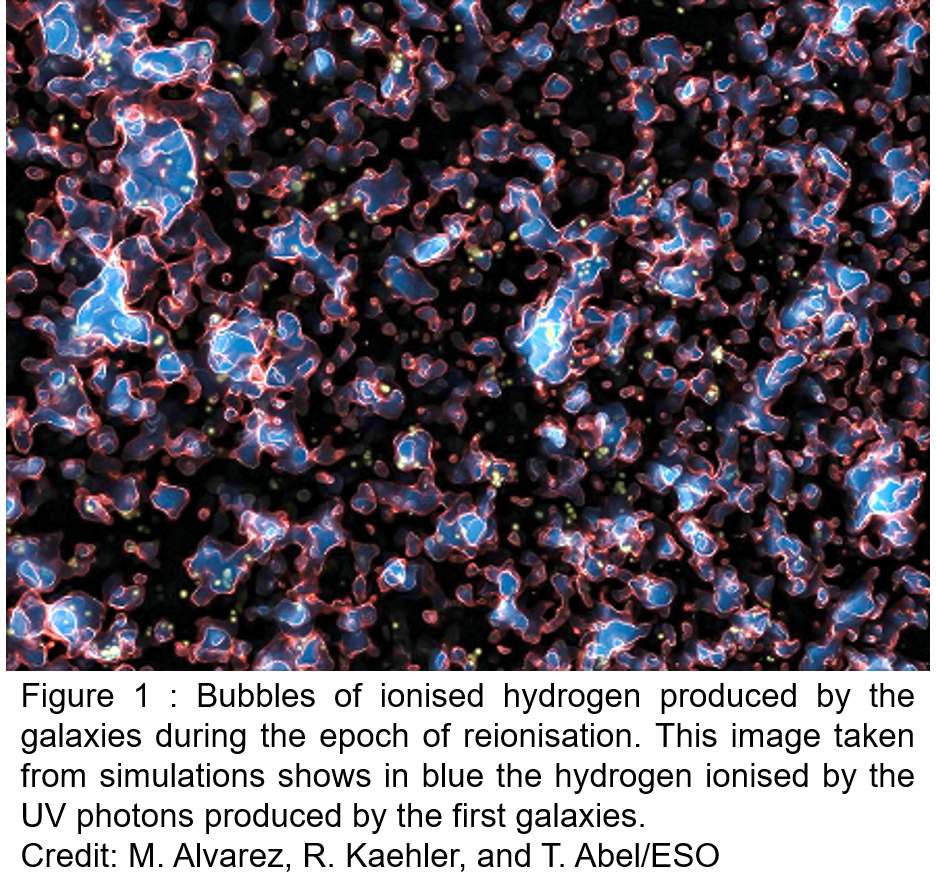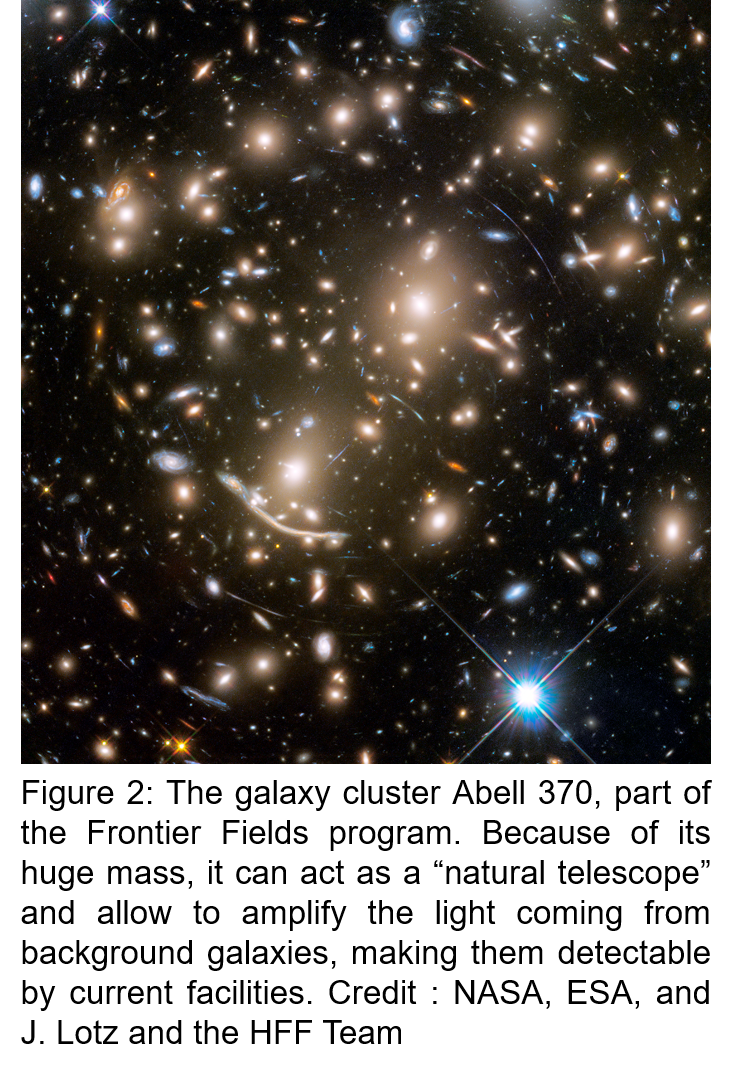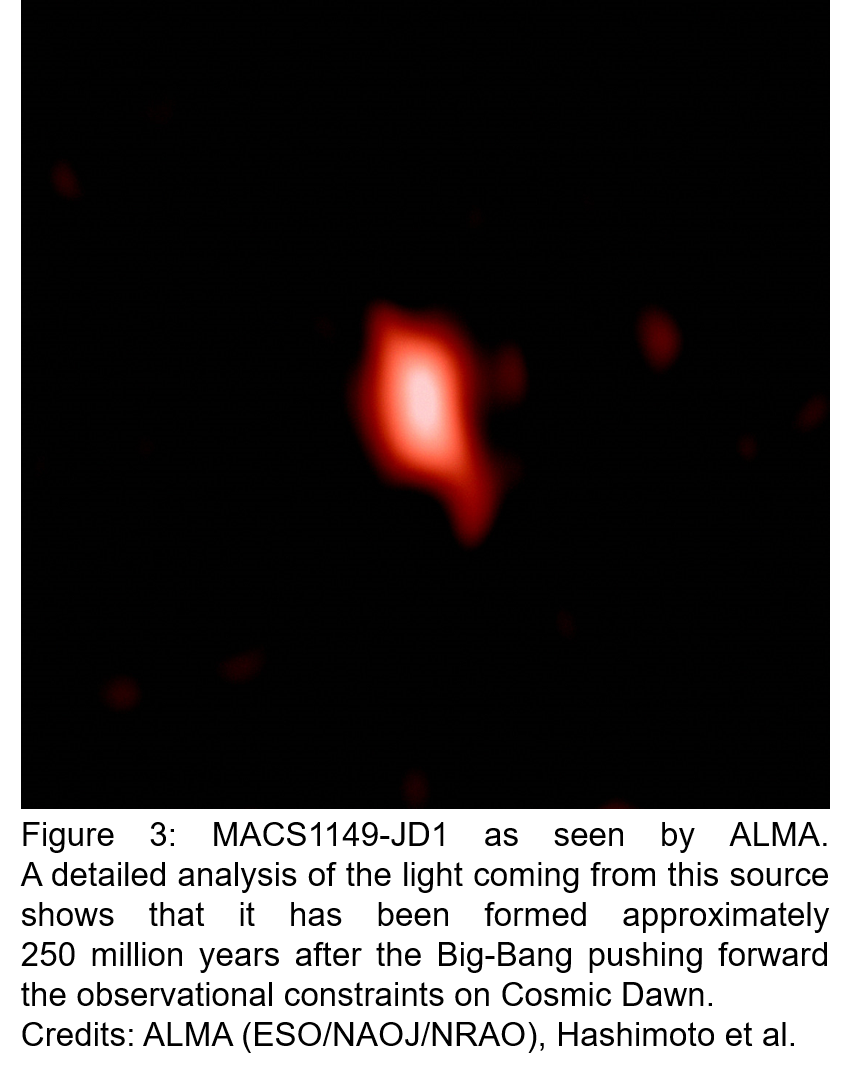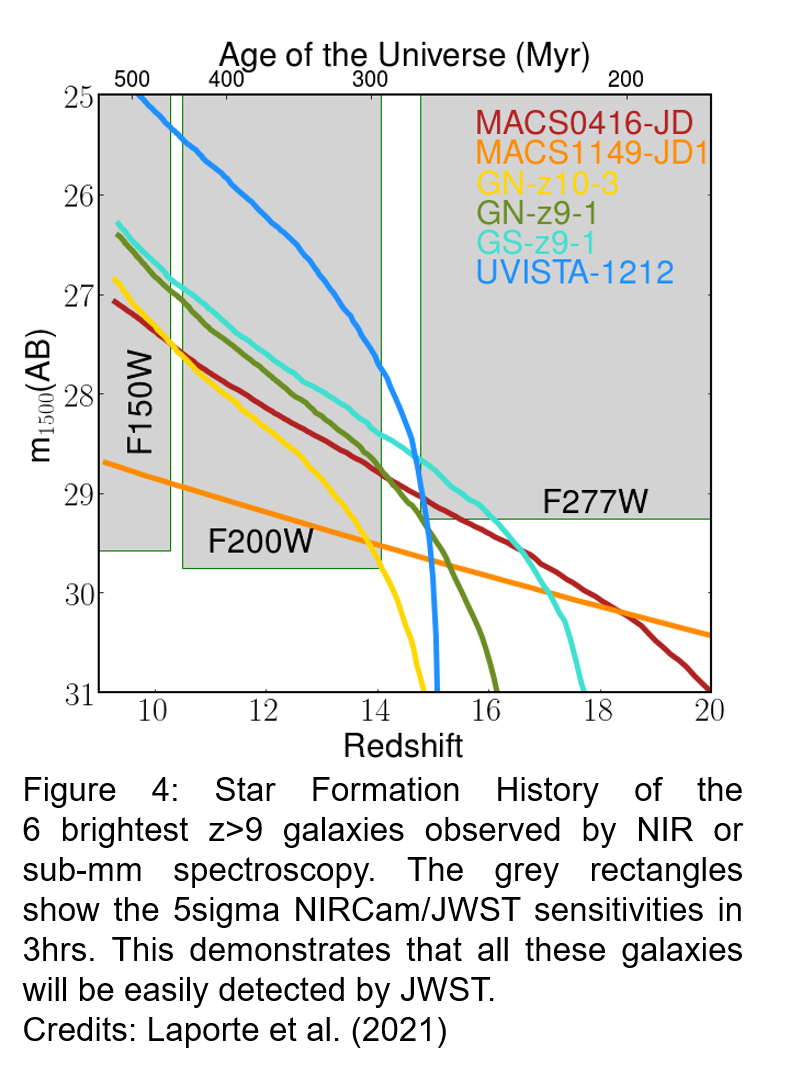Research highlight: Observation of the most distant galaxies
 One of the most exciting challenge of modern extragalactic astronomy is to pinpoint the birth of the first stars and galaxies, or in other words to determine when the Universe became bathed by starlight (aka Cosmic Dawn). According to recent simulations, dark matter haloes massive enough to sustain star formation may exist as early as 150 million years after the Big-Bang (in terms of redshift, z~20), allowing stars to emerge from a dark neutral intergalactic medium. The first stars are expected to be massive and to produce a huge amount of UV photons which start to ionise the neutral hydrogen formed after the Big-Bang. This process, also known as Reionisation, was first a local phenomenon, where each star ionised the neutral hydrogen in its surroundings creating bubble of ionised hydrogen, and became a global process when these bubbles increased in size and merged (Figure 1).
One of the most exciting challenge of modern extragalactic astronomy is to pinpoint the birth of the first stars and galaxies, or in other words to determine when the Universe became bathed by starlight (aka Cosmic Dawn). According to recent simulations, dark matter haloes massive enough to sustain star formation may exist as early as 150 million years after the Big-Bang (in terms of redshift, z~20), allowing stars to emerge from a dark neutral intergalactic medium. The first stars are expected to be massive and to produce a huge amount of UV photons which start to ionise the neutral hydrogen formed after the Big-Bang. This process, also known as Reionisation, was first a local phenomenon, where each star ionised the neutral hydrogen in its surroundings creating bubble of ionised hydrogen, and became a global process when these bubbles increased in size and merged (Figure 1).
Thanks to the latest observations of the Cosmic Microwave Background (CMB) by the Planck satellite, confirmed by observations of the most distant quasars, we can determine that 1 Gyr after the Big-Bang (z~6) hydrogen is mainly ionised in the intergalactic medium marking the end of the Epoch of Reionisation. This time constraint is a boon: it demonstrates that galaxies formed during the first Gyr years of the Universe have emitted enough UV photons to ionise the bulk of neutral hydrogen in the intergalactic medium.
 The logical way to prove that galaxies are responsible for the reionisation of the hydrogen is to count the number of galaxies emitting light during the first billion years of the Universe. In this framework, many deep imaging surveys with the largest ground-based and space telescopes have been conducted, such as the Hubble Ultra Deep Field, CANDELS or UltraVISTA. But because of instrumental limits, these surveys can only observe the brightest galaxies in the early Universe. However according to recent hydrodynamical simulations the faint sources in the early Universe are more numerous than the bright galaxies, and may therefore play a key role in reionising the neutral hydrogen. To go beyond the capabilities of current telescopes, and reach faintest galaxies, we can use “natural telescopes” with a technique called “gravitational lensing”. Indeed, looking through a massive galaxy clusters (Figure 2) allows to amplify the light coming from a background galaxy, making this very distant galaxy brighter and therefore detectable by the current facilities. Many deep surveys have been designed to take benefit from this natural effect to identify the faintest galaxies in the early Universe and explore their properties, as for example CLASH, Frontier Fields or RELICS for the most powerful. Combining results from deep surveys as well as lensing field, we get a better picture of the distribution in luminosity of galaxies, and therefore on their contribution to the ionising photons budget. The conclusion is clear : assuming that galaxies we observed in the early universe have similar properties than galaxies observed in the local universe, they have not produced enough photons during the first billion years of the Universe to explain the reionisation if hydrogen.
The logical way to prove that galaxies are responsible for the reionisation of the hydrogen is to count the number of galaxies emitting light during the first billion years of the Universe. In this framework, many deep imaging surveys with the largest ground-based and space telescopes have been conducted, such as the Hubble Ultra Deep Field, CANDELS or UltraVISTA. But because of instrumental limits, these surveys can only observe the brightest galaxies in the early Universe. However according to recent hydrodynamical simulations the faint sources in the early Universe are more numerous than the bright galaxies, and may therefore play a key role in reionising the neutral hydrogen. To go beyond the capabilities of current telescopes, and reach faintest galaxies, we can use “natural telescopes” with a technique called “gravitational lensing”. Indeed, looking through a massive galaxy clusters (Figure 2) allows to amplify the light coming from a background galaxy, making this very distant galaxy brighter and therefore detectable by the current facilities. Many deep surveys have been designed to take benefit from this natural effect to identify the faintest galaxies in the early Universe and explore their properties, as for example CLASH, Frontier Fields or RELICS for the most powerful. Combining results from deep surveys as well as lensing field, we get a better picture of the distribution in luminosity of galaxies, and therefore on their contribution to the ionising photons budget. The conclusion is clear : assuming that galaxies we observed in the early universe have similar properties than galaxies observed in the local universe, they have not produced enough photons during the first billion years of the Universe to explain the reionisation if hydrogen.

To explain this observed deficit in ionising photons, three main hypothesis can be considered:
(i) there are more faint galaxies than expected, with a luminosity well above the limits of current telescopes,
(ii) the properties of primeval galaxies in terms of ionising photons emission is higher than what is observed in the local Universe
or (iii) the ionising process has started earlier than expected with the formation of galaxies at an earliest epoch in the history of the Universe. Images from the future JWST in 2021 will be the only way to address the first hypothesis by looking for extremely faint galaxies during the first Gyr. To test the second hypothesis, deep high-resolution spectroscopy, such that provided by the future MOONS instrument on the VLT (in which the KICC is strongly involved), is needed to resolve either the most prominent emission line from hydrogen (the so-called Lyman-alpha) or absorption lines from other elements (such as carbon, silicon, etc…).

The last hypothesis can be addressed by determining the age of the most distant galaxies by modelling their Spectral Energy Distribution or by measuring the amount of dust produced by Supernovae along the lifetime of the galaxy. Researchers from the KICC are part of a leading team aiming to estimate the age of the most distant galaxies by combining data coming from Hubble, Spitzer, the VLT, and ALMA. In 2018, they demonstrated that one galaxy (MACS1149-JD1 - Figure 3) emitting light 550 million years after the Big-Bang was already formed 300 Myr earlier (Figure 3). In order to confirm this conclusion, they conducted an extensive spectroscopic follow-up of a complete sample in luminosity of z>9 candidates combining data coming from MOSFIRE/Keck, FLAMINGOS2/Gemini, X-Shooter/VLT and ALMA. They concluded that for the galaxies they observed (which are among the brightest known at such high-redshift) they were all formed prior to z~15 and that their progenitors will be easily detectable with the JWST (Figure 4). The results have been published in 2021.


